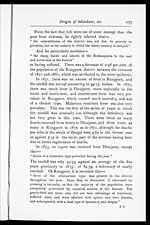Medicine - Institutions > Army health reports and medical documents > Report of an investigation of the epidemic of malarial fever in Assam, or, kala-azar > Section VIII - Origin of kala-azar and its resemblance to the "Bardwan fever" epidemic
(204) Page 176
Download files
Individual page:
Thumbnail gallery: Grid view | List view

176
Report on Kála-ázar.
show to what a great extent fevers were prevalent in this
part of Bengal at the time mentioned, for it does not seem to
have attracted as much attention at the time as might have
been expected. In the Bengal Census Report for 1881, it
is recorded as follows:
"Dinajpore has made no progress at all during the last nine years,
for the advance of the population has only been 0.28 per cent., which
would be much more than accounted for by better enumeration. This
pitiable result is due only to the ravages of malarious fever, for which
this district has as evil a reputation as its neighbour, Rungpore. In
1872, the reported deaths from fever in Dinajpore were higher than in
any other district in the Rajshahye division. The four following
years showed little improvement, and in 1876, the fever mortality was
22.05 per mille of the whole population. In 1877, which a general
consensus of opinion declares to have been the most unhealthy year
in this district within living memory, this rate rose to 30.06, and
36,000 deaths were reported from this cause alone. Out of 17 adult
Europeans 15 had to leave the district during the year broken by
repeated attacks of fever, and official business could hardly be carried
on.......... It so happened that this district was at the time that in
which death registration was best carried out in all Bengal; and it
was found that the death-rate in the municipality was 42 per mille,
nearly double the death-rate of London, while the police died at the
rate of 46, and the prisoners in the jail at the rate of 74.6 per mille
per annum."
Again, of Rungpore, it is recorded that—
"Rungpore fever has passed into a proverb in Bengal, and
though it is now thanks to improved drainage, less virulent than
formerly in the town of Rungpore itself, its effects on the population
of district are still widespread and unmistakable. It is a slow,
lingering fever, usually attended with spleen and liver complications,
and leading in the winter months to dropsy, phthisis, and other
pulmonary affections."
As early as 1874, the Civil Surgeon reported, after a
special inquiry, that—
"Eighty per cent. of the people were anæmic or suffered from
enlarged spleen, or were laid up with illness, while the 20 per cent.
found healthy could not be considered so in the European sense
of the word."
Set display mode to: Large image | Zoom image | Transcription
Images and transcriptions on this page, including medium image downloads, may be used under the Creative Commons Attribution 4.0 International Licence unless otherwise stated. ![]()
| Permanent URL | https://digital.nls.uk/75014861 |
|---|




